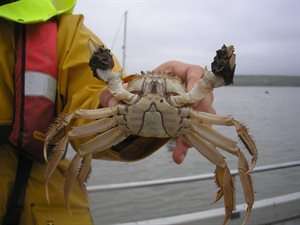Chinese mitten crab invades Scotland and poses threat to salmon and trout

The Chinese mitten crab, recorded in Scotland for the first time, poses a serious potential threat to salmon and trout in Glasgow's River Clyde, according to researchers from Royal Holloway, University of London, and the Natural History Museum.
The invasive crab species, named after the furry mats covering its claws, is one of the top 100 worst alien species in the world and threatens biodiversity by competing for food, preying on native species and causing severe structural damage to riverbanks through burrowing.
The Mitten Crab Recording Project has already confirmed the crabs have populated rivers in the UK as far north as the Tyne, but this sighting in Glasgow's River Clyde confirms its presence over the Scottish border for the first time.
Dr David Morritt and Jessica Webster, from the School of Biological Sciences at Royal Holloway, who have been studying the crabs in collaboration with Dr Paul Clark at the Natural History Museum, are concerned about the enormous environmental risk in the area.
Dr Morritt said: "Our laboratory feeding trials with sub-adult Chinese mitten crabs reveal that the crabs apparently show a preference for larger eggs which are easier to handle and probably more profitable in terms of energy gained. The occurrence of these Chinese mitten crabs in a Scottish river could have a devastating impact on the famous salmon and trout fishing rivers should they manage to reach parts of the catchments where these fish spawn."
The Chinese mitten crab, Eriocheir sinensis, is native to East Asia but is now found across NE Europe and the USA. It was first recorded in the River Thames in 1935, probably introduced by shipping. In the late 1980s the mitten crab began to disperse westwards along the Thames, and there are now well-established populations of E. sinensis in a number of Welsh and English rivers, as well as a single sighting in Ireland in 2006.
Provided by Royal Holloway, University of London


















